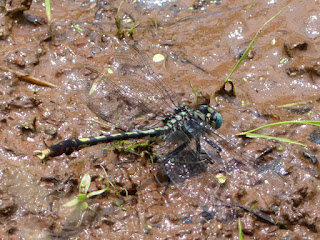Behold a Unicorn (Clubtail Dragonfly)
Those of us living in the real world don't get a chance to see unicorns ... unless they are Unicorn Clubtail dragonflies, that is. But while the mythical unicorn has a very prominent horn, the Unicorn Clubtail has a more modest point on their occiput (an area between the eyes at the top of the head). Although some descriptions call this point "conspicuous":
- It's pretty easy to miss it as a field mark, and isn't even easy to see in pictures like the 1 below.
- On the other hand, if you're an entomologist examining a captured dragonfly, it suddenly becomes a very useful way of identifying these guys.
Clubtail dragonflies are a bit different from the average dragonfly:
- Their abdomens are mostly thinner than other types of dragonflies, but which widen at the last few segments (S7-S9) into something like a club. At least this is usually true for the clubtails, though there are some species with virtually no club. (Unfortunately for the club analogy, the clubtails aren't known to go around clubbing things with their clubs.)
- There's little sexual dimorphism between males and females, though females usually have smaller clubs than the males of their species. (Females usually have somewhat paler coloring too.)
- There's usually more space between their eyes than you see in dragonflies; in this way (and also the slender abdomens) they're a little bit like damselflies. Staying with the eyes, most clubtail eyes are blue or green or something in between. Admittedly other dragonflies share this trait; I'm looking at you, Blue Dasher.
They're not known for spending a lot of time on the ground, but dragonflies are known to imbibe in a little water. Perhaps the water in the mudpuddle was an attraction to it.
 |
| June 15, 2023 at Sourland Mountain Preserve Photo 300989051, (c) jpviolette, some rights reserved (CC BY-NC) |



Comments
Post a Comment